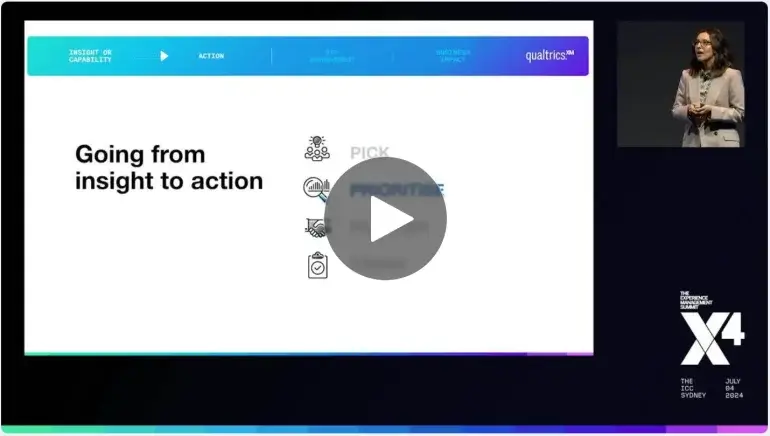
Customer Experience
10 questions (and answers) from “What’s the Future of CX?”
Even in the midst of continued inflationary pressures that increase consumer price sensitivity, Qualtrics’ research found that what drives purchase decisions is the post-purchase experience. In the same research, we found that 66% of customers don’t tell the organization if they’ve had a bad experience.
So as CX continues to rise in importance as a differentiator, how can organizations ensure their programs are fit for the future?
At the recent “What’s the future of Customer Experience?” webinar that I hosted (featuring a few of our global experts), we explored how organizations can listen deeply at scale, and how to turn those insights into valuable business outcomes. Here are some of the top questions asked during the session and my responses that I thought are worth sharing with other CX practitioners out there.
1. With a CX program that offers us continuous information and insights, how do we avoid the business constantly 'chopping and changing' strategy?
I'd recommend adopting more of an agile experimenting approach - instead of drastically changing the entire strategy every single time that could manifest in fragmented customer experiences and a very mis-aligned organization.
By introducing small-scale pilots, organizations can test new strategies or concepts without overhauling entire business plans. This approach allows for real-time feedback and validation. Organizations should identify key areas for experimentation, set clear objectives, and measure success using key performance indicators (KPIs) that reflect customer experience, such as satisfaction scores or Net Promoter Scores (NPS). With the pilot, you can then make a data-informed decision to either pivot, or to scale. As such, having agile tools that allow you to make quick and partial changes to measure these indicators is also something you should consider.
2. You've mentioned Embedding Human Empathy in decision-making and operating processes. How do you suggest getting employees to adopt the human empathy mindset?
Creating a culture that prioritizes empathy is essential for understanding customer needs and delivering exceptional experiences. This can be achieved through various strategies that emphasize emotional connection. Initiatives such as hosting Customer Experience (CX) workshops for cross-functional departments or providing immersive experiences, like “a day in the life of a customer” allow employees to gain firsthand insights into customer challenges and perspectives.
Regularly sharing customer feedback and success stories within the organization also reinforces the importance of empathy in decision-making.
Taking it one step further, integrating customer-centric metrics into performance evaluations helps employees understand the direct impact of their actions on customer satisfaction, fostering a company-wide commitment to empathetic interactions.
3. Is a Customer Promise essential for a modern CX strategy?
A customer promise would be a form of illustrating a company's vision for their customer experience. Whilst not all companies have a specific promise, a clear CX vision is very crucial for evolving customer experience programs as it will help keep your eyes on the prize instead of getting caught up in the specific parts of a program, like the scores received or response rates.
Having a clear vision also helps align various departments which may have their own concerns or agendas work in the same direction.
4. How do we determine the ROI of our CX investments?
Measuring the return on investment (ROI) for CX initiatives is vital for validating their effectiveness and justifying further investments.
To effectively measure ROI, it is crucial to identify specific metrics before launching a CX initiative, including customer retention rates, average revenue per customer, or reductions in churn.
This guide may be helpful in determining the ROI, and we also have an ROI of CX Guide here.
5. We are really early in our CX program journey, and one of things the team is struggling with is driving behavioral changes in getting our sales team to record feedback (either not recording at all or recording poor quality data). Any suggestions on navigating this?
Engaging the sales team in customer feedback collection is essential for B2B companies in developing a comprehensive view of customer interactions and improving overall CX. Sales teams are often on the front lines interacting directly with customers, yet gathering feedback can be perceived as cumbersome or time-consuming.
I’d look at it from two areas:
- Technology enablement: Streamlining the feedback process and embedding it into their daily workflows can lead to higher participation rates. For instance, companies can implement user-friendly tools that integrate feedback collection channels into existing work processes, applications and devices. Some organizations use voice or video recordings to collect frontline feedback and use machine transcription to digitalize the feedback. Others build surveys into their frontline apps so they can collect quick ratings / verbatims after each interaction.
- Incentivize: If uptake is low, consider offering incentives or recognition programs to encourage adoption. It would also help to identify one or two win cases where the feedback that they have provided have helped change certain processes or products that have ultimately benefited the sales team so that they see the value and would be more motivated to help.
6. How can we effectively analyze unstructured customer feedback?
Unstructured feedback, such as open-ended survey responses or customer comments on social media, can provide deep insights into customer perceptions and attitudes but analyzing it can be complex. Unlike structured data, unstructured feedback often contains rich qualitative insights that can help paint a fuller picture of customer sentiment.
To effectively analyze this type of feedback, I would recommend starting with journey mapping exercises to visualize customer interactions and pinpoint key touchpoints where unstructured feedback might occur. Once you have that data, tools like Qualtrics® Text IQTM analyze it to interpret feedback more efficiently, transforming raw data into actionable insights. Regularly review findings with relevant teams to ensure you’re extracting meaningful conclusions.
7. What recommendations do you have for fledgling Voice of the Customer (VoC) programs to improve adoption?
New Voice of the Customer (VoC) programs face challenges in driving organizational buy-in and engagement. Fostering excitement around VoC initiatives and demonstrating their value can significantly accelerate adoption.
A few areas that I would recommend considering:
- Celebrate the small wins: Gaining momentum is important. Take every opportunity to share early successes, such as improved customer satisfaction derived from feedback and encourage further participation across teams. Sharing such wins through town halls, CX newsletters, or internal communications channels can add visibility to the program’s impact.
- Securing senior stakeholders buy-in: Spend the extra effort upfront in developing a strong business case that showcases the benefits. This is crucial to align resources (and budget!) effectively.
- Utilize champions: Identify one or two key business units that have strong champions aligned to what you are trying to achieve and focus your efforts on them. Once you have the initial wins, share them (as mentioned in the first point) to gain more buy in.
8. Where can I find more information about Customer Effort Score using Qualtrics?
Understanding and implementing Customer Effort Score (CES) is vital for tracking how easy or difficult it is for customers to interact with your brand. CES quantifies customer effort, typically correlating ease of interaction with customer satisfaction and loyalty.
Check out this blog post on Customer Effort Score that contains recommendations and resources.
With Qualtrics, you can build CES survey programs, and most Qualtrics licenses come with our Transactional Customer Effort Score (CES) automated project that helps you get off the ground quick. Request a demo today to see how we can help.
9. How long does it take for large companies to transition to a culture of human empathy?
The timeframe for large companies to transition to a culture that genuinely values human empathy varies significantly based on factors such as organizational structure, culture, and existing practices. Large organizations often encounter internal silos that can impede collaboration and a holistic understanding of customer needs, leading to delays in cultural shifts.
To navigate this transition effectively, businesses should conduct a maturity assessment to identify gaps and opportunities for cultivating empathy within their operations. This assessment can serve as a roadmap, highlighting areas that require focus, such as communication improvements, training initiatives, and leadership alignment.
10. With AI on the rise, will dashboard results be interpreted automatically, and who sets this up?
The AI that Qualtrics is developing is helping to surface insights from the dashboard either automatically or based on your queries. The Qualtrics AI is optimized to read these CX dashboards to provide the relevant insights. You can provide feedback on the insights and the model will take that into account for further training.
Move from basic insights to proactive customer engagement strategies

